Showdown Galaxy Note II - all about hardware
The first part of the review, in which we look at the screen, get into the giblets, find out a detective story about the missing and found second microphone and something else.
Everyone knows that if you have not climbed into the giblets of your device, this is not considered full ownership. Getting to the autopsy!


The insides.
First you need to open the lid by pulling the notch with your fingernail: The
lid is held on small plastic latches:
Which, despite the seeming unreliability, have a significant plus - there are a lot of them:
In addition, the performance plastic is very flexible:
Yes, and the lid proved itself well in the first phone version, and therefore I can’t say anything bad about her unreliability. I
’ll say good, for example, an NFC antenna: If I had one more cover, I would definitely open and look inside, but alas.
Below is just the speaker’s hole and a notch for the stylus, nothing interesting:
Okay, enough to suffer from garbage cover, in front of us the patient is more interesting, the phone itself:






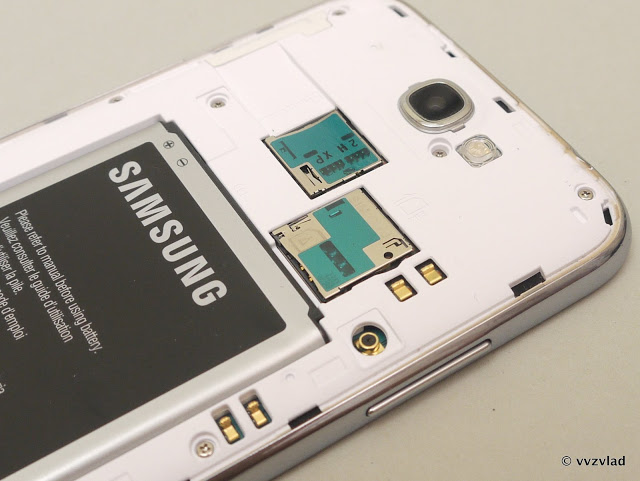
In the upper part there are two slots - for MiniSIM and MicroSD. I wanted to sign them in the photo, but it turned out that Samsung engineers did it for me, thanks to them. In the lower part there is a speaker grid, antenna, stylus. Battery capacity 3100 mAh Pretty heavy and weighty. The patient remained completely defenseless: Consider it from all angles, without any embarrassment. We see the drowning indicator (yellow arrow). To remove the back of the case we have to unscrew 11 (!) Screws. But if you think that this will end, you are mistaken. Next, you need a couple of mediators or plastic " openers

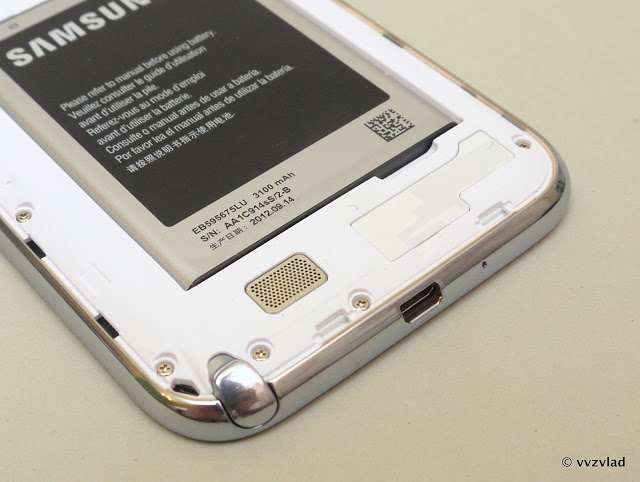



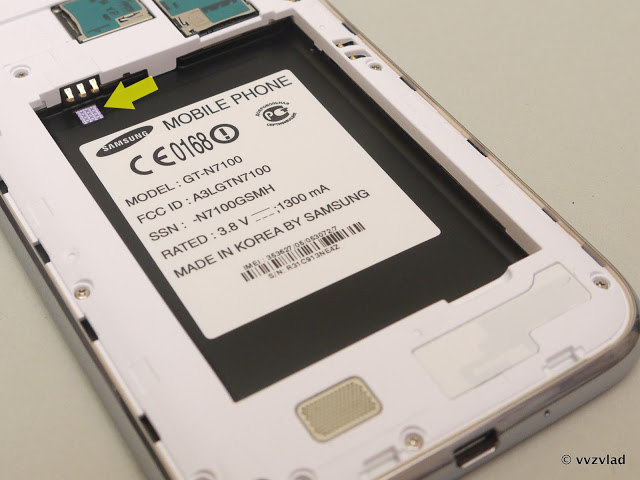
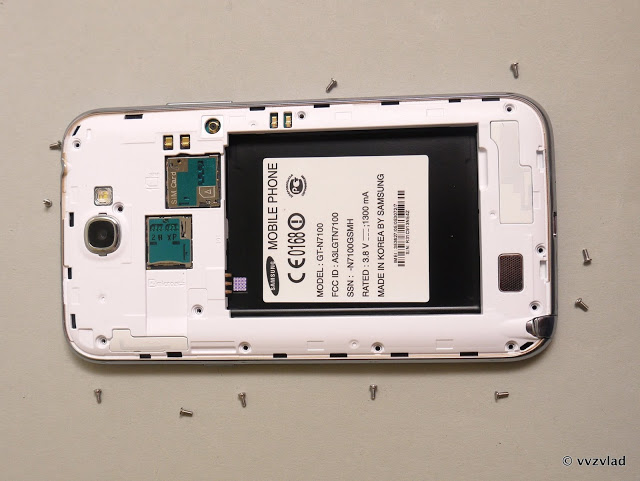
"for devices. They need to firmly, but gently walk along the perimeter of the silver frame from the side of the screen (the frame is integral with the white plastic back), and unfasten all the latches: But even after these actions the phone still cannot be opened : Two latches interfere , the one in the photo, and on the other side of the battery compartment. We unhook them to taste, either lifting the lid with brute force or gently poking with needles on both sides. So, the most difficult stage of disassembly is completed. We have a plastic panel with one more indicator drowning (si Thread needle): With a very complex mold.


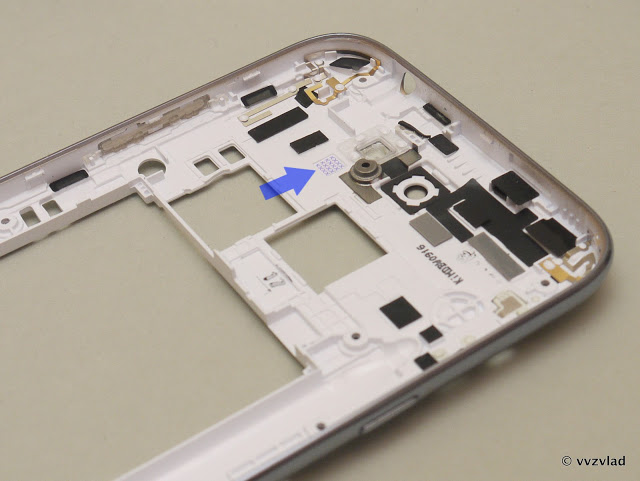

A huge number of stiffeners, props, latches, different thicknesses of plastic in the most critical places and other joys of housing developers. These are the latches that did not want to be snapped off, the bottom one: And the top one: We are interested in what we all started for, electronics: Here, for example, a micro switch that is used as a stylus sensor, isn’t it cute? Pressed with a stylus: A little from a different angle: Well, one more photo is closer, and I won’t go any further, go further: A flash, a camera, a speaker and an audio jack : A vibro motor (yellow arrow) and a Wacom sensor controller (blue):

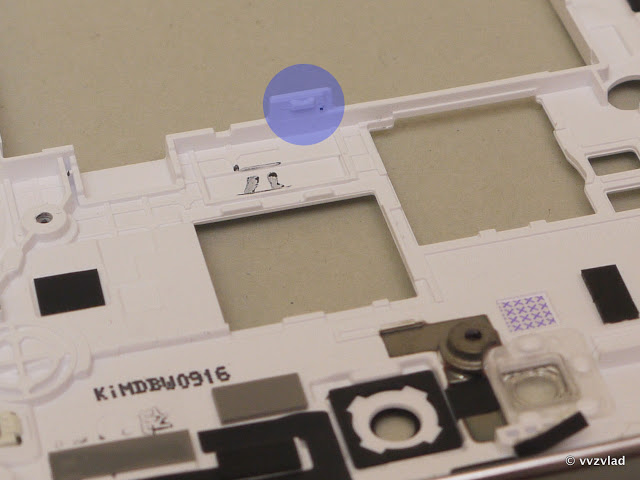

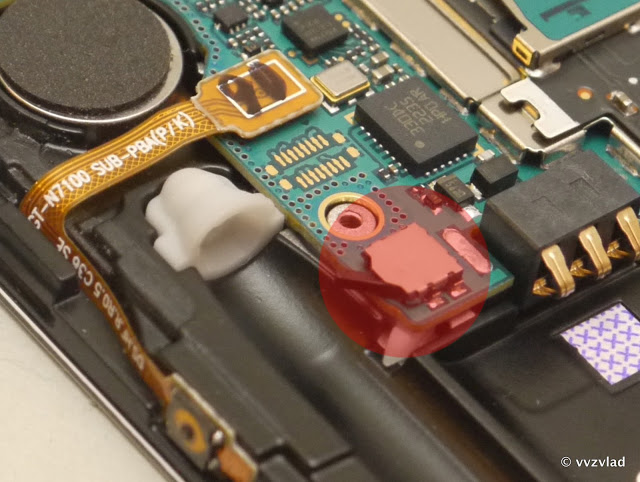
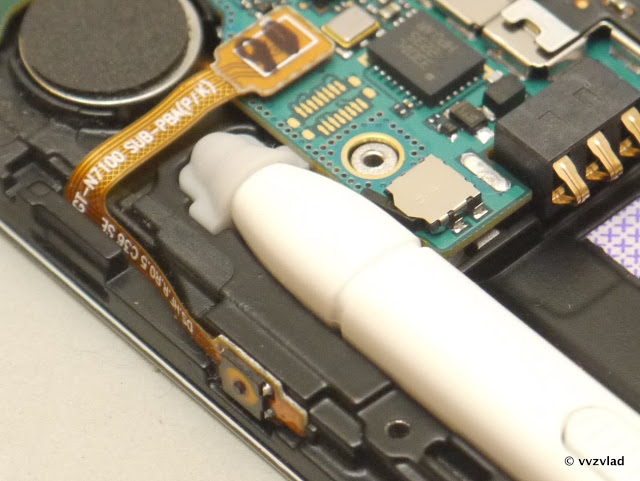

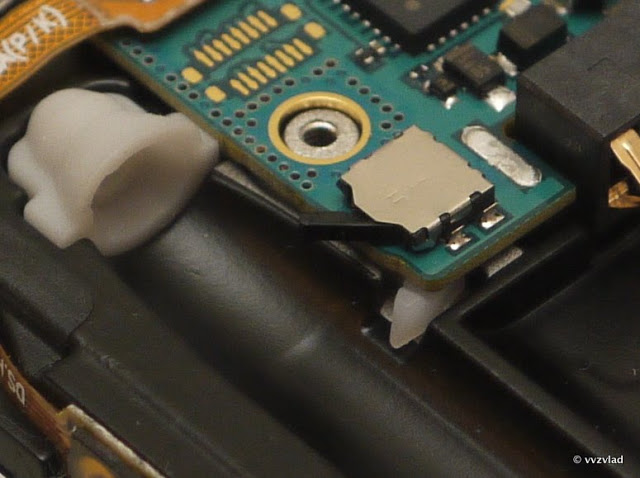

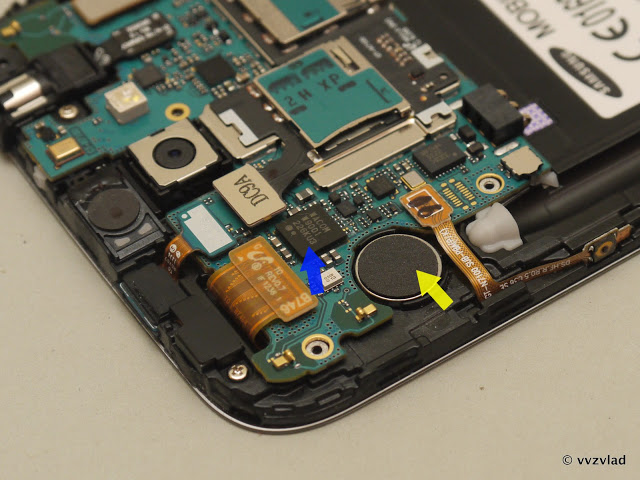
All connections are made by cables, which is more maintainable than soldering. To remove the board, we need to disable them all. 5 pieces marked in red, you see in this picture (blue can not be turned off) And two more jokes (red) and an antenna plug. And also unscrew the screw (green arrow): And, voila, we have a board in front of us, whose shape has not undergone any changes since the first Note. And the rest of the case with the screen: Pay attention to the thermal interface gasket above the processor (green arrow), the vibration motor contacts (blue), and the stylus-pen lock (yellow). The latter is more detailed: OI / AAAAAAAAKgk / oAK7d_23Iig / s640 / P1240019.JPG "height =" 481 "width =" 640 "/> And with a stylus:


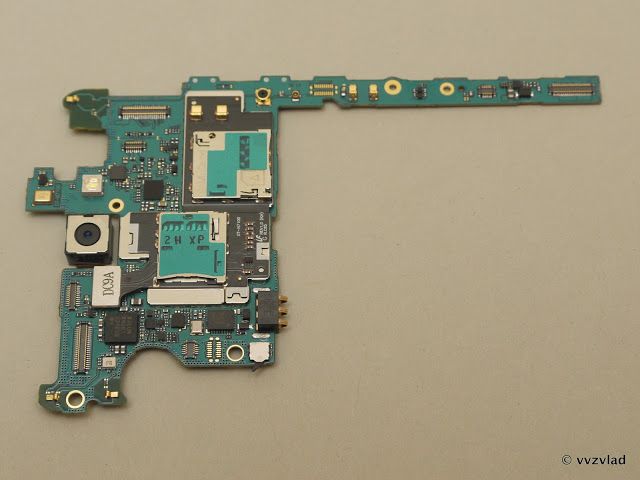


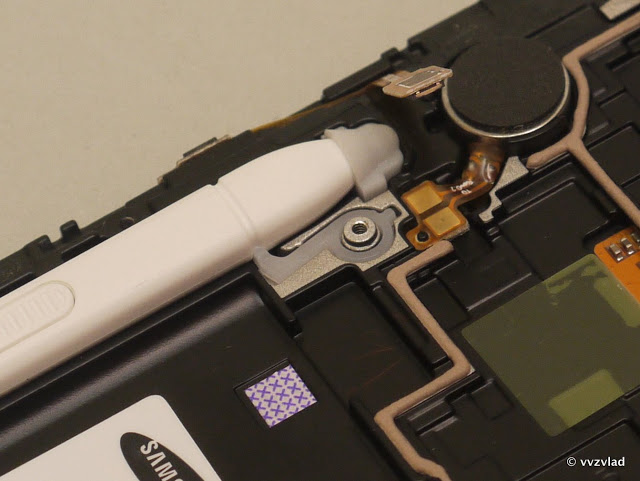
The latch falls into the groove at the end of the stylus (that's why it is needed), and securely fixes it in place.
Damn, I promised. All, I won’t. So this is not the same node from a different angle, it is just a power button: Membrane. Therefore, she is so slurred. There are no metal shields on the back of the board, because the internal chassis (black surface) is a screen in itself, it is metal (yellow arrow). At the same time, we increased the rigidity of the structure and solved the problem of heat removal: It is also interesting that the seal (red) is electrically conductive, and critical places (green) are additionally protected by insulating gaskets. Pay:

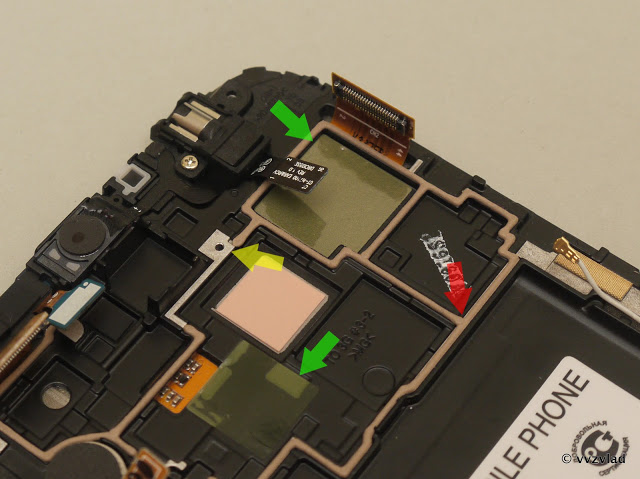
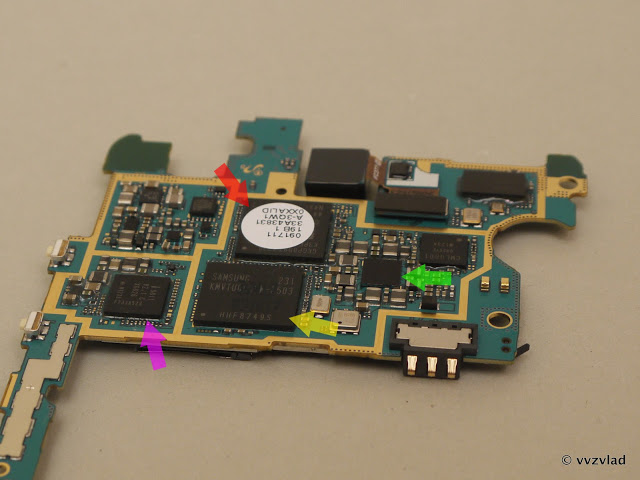
The red arrow is the processor, the yellow is the memory, the green is the power controller, and the lilac is the modem. Okay, there’s nothing more interesting here, we’ll go down below. Unscrewing one screw (blue), remove the speaker module and antennas: What's so interesting? Speaker contacts (green), antenna contacts (yellow), microphone (blue), and tricky - in a special silicone thing, and with a digital interface. By the way, there is the same place for a microphone in the upper part of the case:But there is no microphone on the board, heh. Well, okay, I myself know how this happens - they designed it, but did not go into the series. Maybe it turned out to be so well audible, maybe they thought it was disadvantageous, maybe programmers improved the filter. The funny thing is that the silicone pad is still diligently placed under a non-existent microphone.
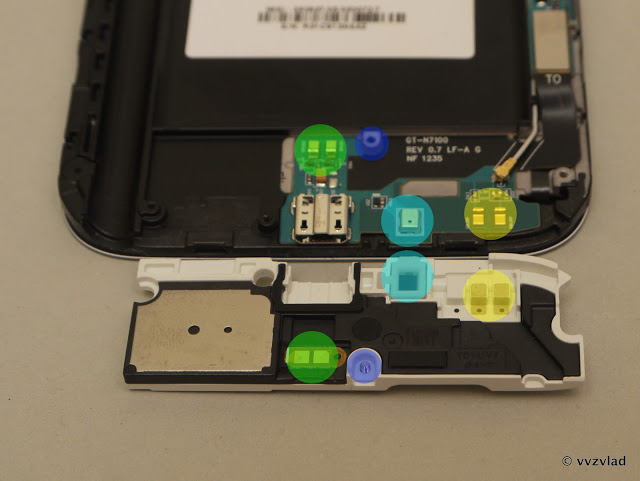
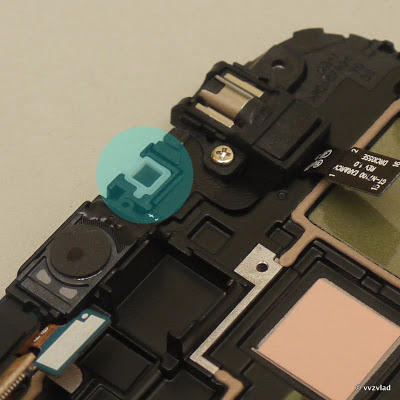
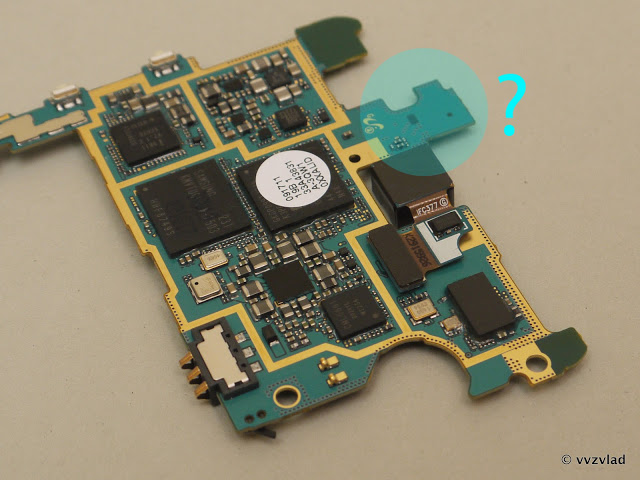
UPD: There is still a microphone there, on the back of the board. I saw him, but the lack of a hole on him, and the fact that he, on the other hand, led me astray.
Here it is: Just in a different version, with a hole below: Comrade Oleg, a telephone repairman who wrote me in the mail, brought clarity. By the way, the microphones are closer: And this is the outside: This is the bottom part where the microphone is. And here is the top one with an empty place: In the first Note, the microphone, by the way, was on the bottom side of the board: It is assembled much easier - we “put on” the panel with the frame on the rest and push it until it clicks. Then tighten the screws.
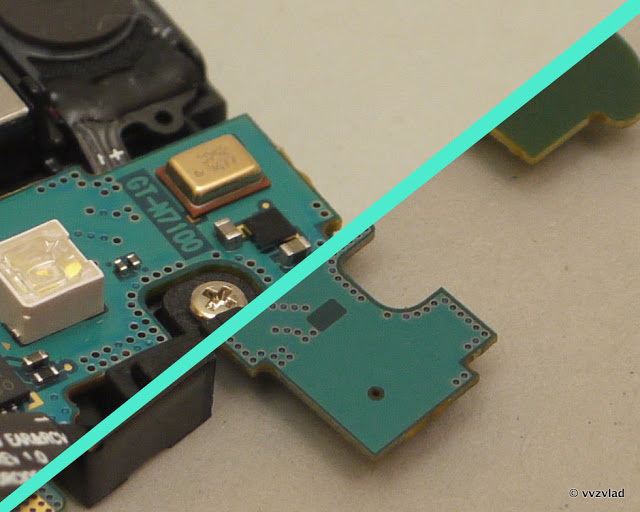
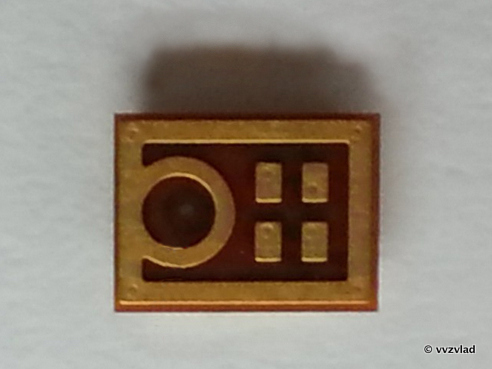

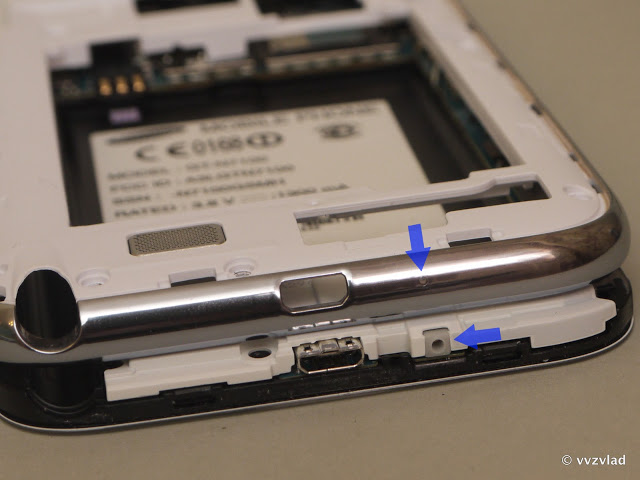

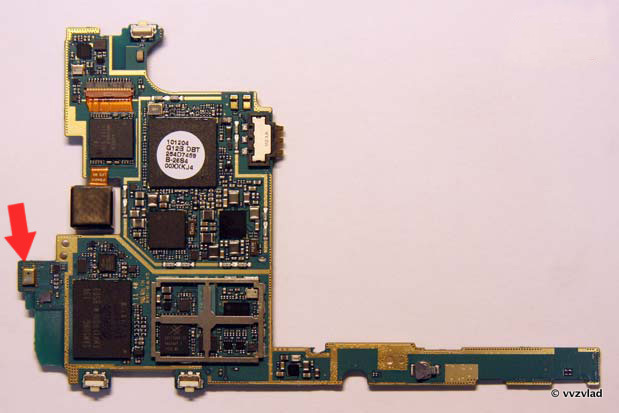
Screen.
The matrix in the phone is AMOLED, which means that there is no backlight, no three types of filters, no LCD shutters. There are just three color LEDs.
For comparison, I shot the screen of my THL W3 and Note II phone (the Chinese have a slightly smaller pixel size, but there isn’t much difference in perception): Do you notice anything? Yes, PenTile is now a story!! 11dynodynodin.
By comparison, the PenTile screen:
No more weird effects on sharp borders and artifacts on dark photos.
And this is new:
A little further:
Here, I’ll take another picture from GSMArena.com: The
subpixels are more compact, due to which the pixel will not blur in all directions. In addition, the resolution was increased slightly by reducing the linear size of the pixel.

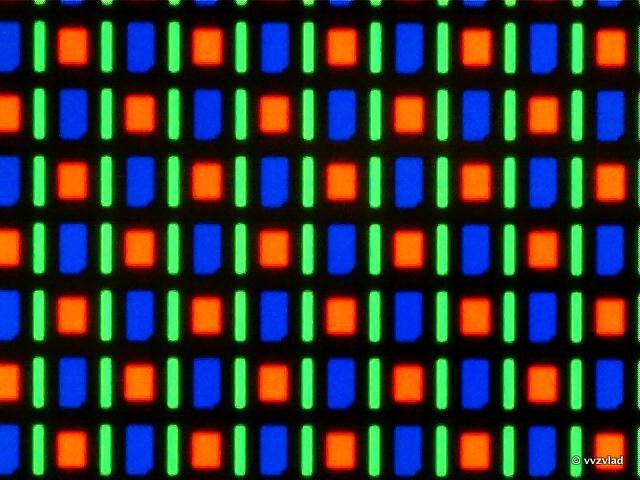
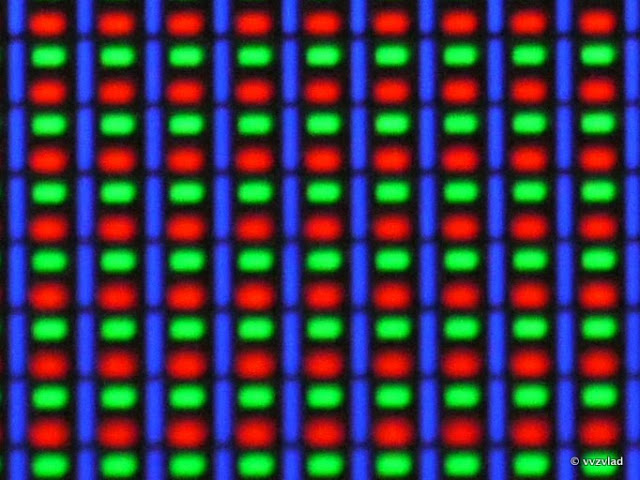

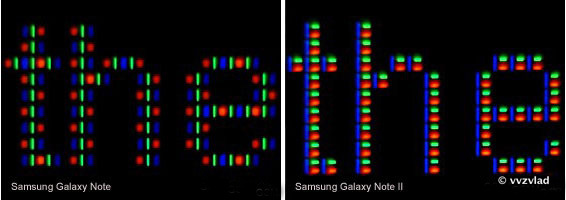
You can see all the photos from the review (and many not included) in the original resolution in the Picasa album . There you can ask a question or leave a comment.
And you can subscribe so as not to miss new reviews on the company page and in my profile (the “subscribe” button)


The insides.
First you need to open the lid by pulling the notch with your fingernail: The
lid is held on small plastic latches:
Which, despite the seeming unreliability, have a significant plus - there are a lot of them:
In addition, the performance plastic is very flexible:
Yes, and the lid proved itself well in the first phone version, and therefore I can’t say anything bad about her unreliability. I
’ll say good, for example, an NFC antenna: If I had one more cover, I would definitely open and look inside, but alas.
Below is just the speaker’s hole and a notch for the stylus, nothing interesting:
Okay, enough to suffer from 






In the upper part there are two slots - for MiniSIM and MicroSD. I wanted to sign them in the photo, but it turned out that Samsung engineers did it for me, thanks to them. In the lower part there is a speaker grid, antenna, stylus. Battery capacity 3100 mAh Pretty heavy and weighty. The patient remained completely defenseless: Consider it from all angles, without any embarrassment. We see the drowning indicator (yellow arrow). To remove the back of the case we have to unscrew 11 (!) Screws. But if you think that this will end, you are mistaken. Next, you need a couple of mediators or plastic " openers







"for devices. They need to firmly, but gently walk along the perimeter of the silver frame from the side of the screen (the frame is integral with the white plastic back), and unfasten all the latches: But even after these actions the phone still cannot be opened : Two latches interfere , the one in the photo, and on the other side of the battery compartment. We unhook them to taste, either lifting the lid with brute force or gently poking with needles on both sides. So, the most difficult stage of disassembly is completed. We have a plastic panel with one more indicator drowning (si Thread needle): With a very complex mold.




A huge number of stiffeners, props, latches, different thicknesses of plastic in the most critical places and other joys of housing developers. These are the latches that did not want to be snapped off, the bottom one: And the top one: We are interested in what we all started for, electronics: Here, for example, a micro switch that is used as a stylus sensor, isn’t it cute? Pressed with a stylus: A little from a different angle: Well, one more photo is closer, and I won’t go any further, go further: A flash, a camera, a speaker and an audio jack : A vibro motor (yellow arrow) and a Wacom sensor controller (blue):









All connections are made by cables, which is more maintainable than soldering. To remove the board, we need to disable them all. 5 pieces marked in red, you see in this picture (blue can not be turned off) And two more jokes (red) and an antenna plug. And also unscrew the screw (green arrow): And, voila, we have a board in front of us, whose shape has not undergone any changes since the first Note. And the rest of the case with the screen: Pay attention to the thermal interface gasket above the processor (green arrow), the vibration motor contacts (blue), and the stylus-pen lock (yellow). The latter is more detailed: OI / AAAAAAAAKgk / oAK7d_23Iig / s640 / P1240019.JPG "height =" 481 "width =" 640 "/> And with a stylus:






The latch falls into the groove at the end of the stylus (that's why it is needed), and securely fixes it in place.
Damn, I promised. All, I won’t. So this is not the same node from a different angle, it is just a power button: Membrane. Therefore, she is so slurred. There are no metal shields on the back of the board, because the internal chassis (black surface) is a screen in itself, it is metal (yellow arrow). At the same time, we increased the rigidity of the structure and solved the problem of heat removal: It is also interesting that the seal (red) is electrically conductive, and critical places (green) are additionally protected by insulating gaskets. Pay:



The red arrow is the processor, the yellow is the memory, the green is the power controller, and the lilac is the modem. Okay, there’s nothing more interesting here, we’ll go down below. Unscrewing one screw (blue), remove the speaker module and antennas: What's so interesting? Speaker contacts (green), antenna contacts (yellow), microphone (blue), and tricky - in a special silicone thing, and with a digital interface. By the way, there is the same place for a microphone in the upper part of the case:



UPD: There is still a microphone there, on the back of the board. I saw him, but the lack of a hole on him, and the fact that he, on the other hand, led me astray.
Here it is: Just in a different version, with a hole below: Comrade Oleg, a telephone repairman who wrote me in the mail, brought clarity. By the way, the microphones are closer: And this is the outside: This is the bottom part where the microphone is. And here is the top one with an empty place: In the first Note, the microphone, by the way, was on the bottom side of the board: It is assembled much easier - we “put on” the panel with the frame on the rest and push it until it clicks. Then tighten the screws.






Screen.
The matrix in the phone is AMOLED, which means that there is no backlight, no three types of filters, no LCD shutters. There are just three color LEDs. For comparison, I shot the screen of my THL W3 and Note II phone (the Chinese have a slightly smaller pixel size, but there isn’t much difference in perception): Do you notice anything? Yes, PenTile is now a story!





You can see all the photos from the review (and many not included) in the original resolution in the Picasa album . There you can ask a question or leave a comment.
And you can subscribe so as not to miss new reviews on the company page and in my profile (the “subscribe” button)
